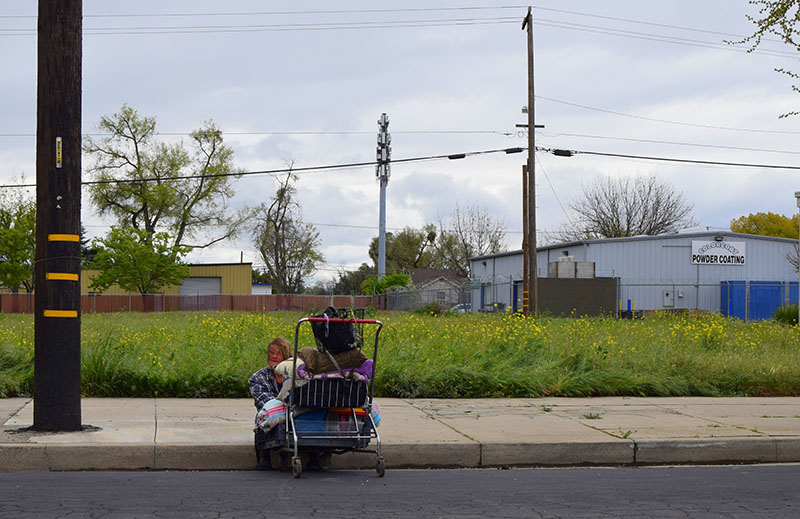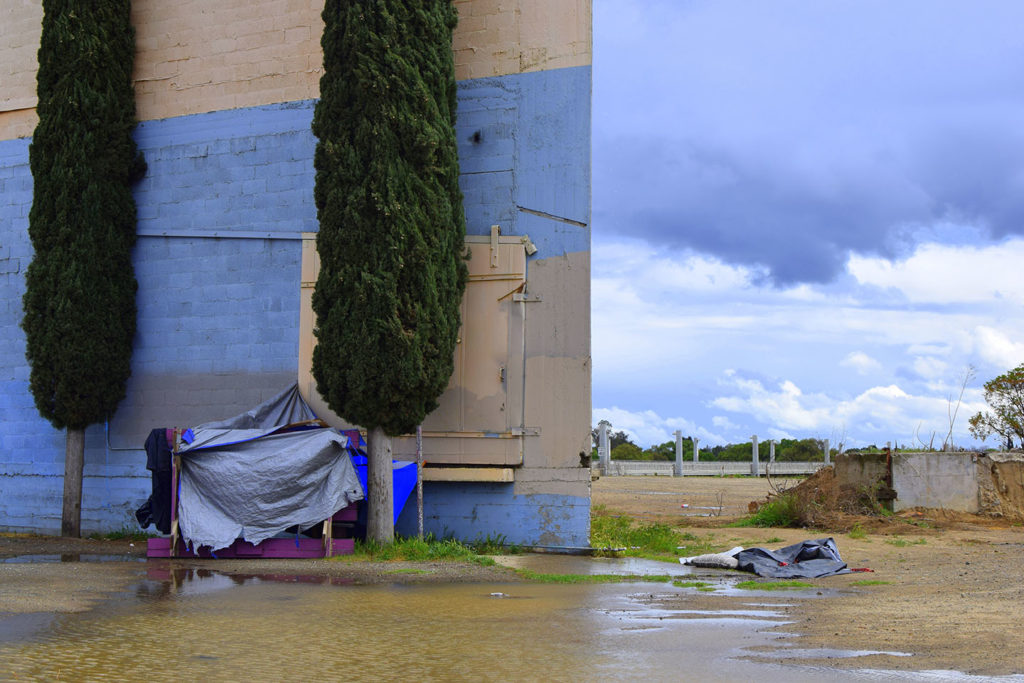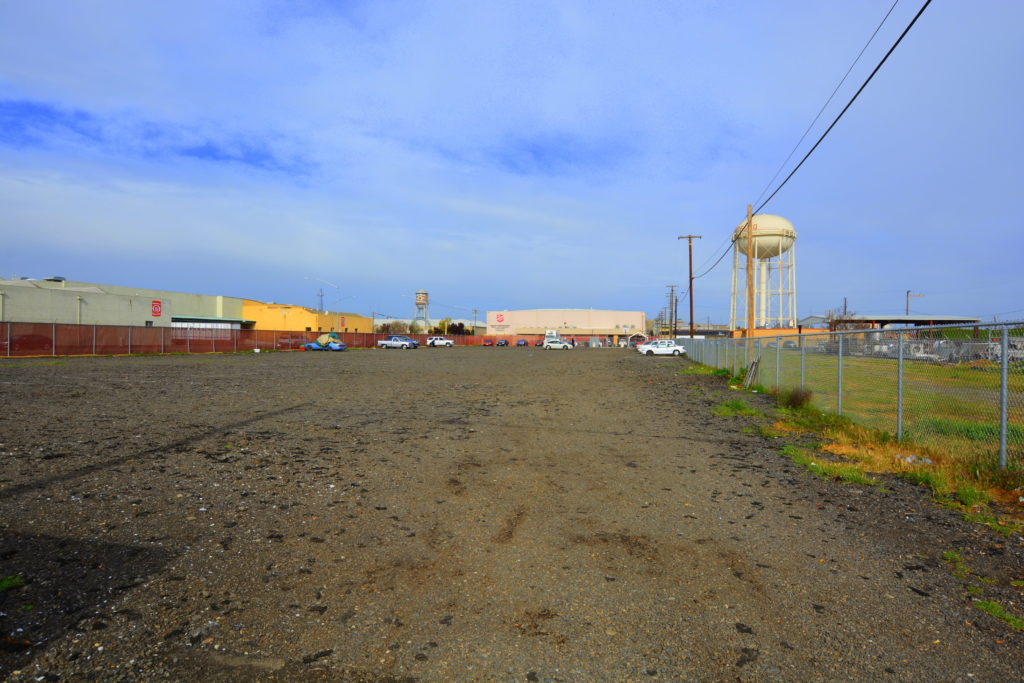Imagine some of the most vulnerable residents in your town being chased from place to place during a pandemic. Imagine that their only access to hygiene is public restrooms, back alleys, and the great outdoors. Fanciful as it may sound, that’s exactly the case with members of Modesto’s homeless population who didn’t make it into the county’s new 182 bed shelter on 9th and D Streets in Modesto.
When the Modesto Outdoor Emergency Shelter (MOES) closed last fall, it had accommodated well over 400 people. Most hoped to enter the new low-barrier facility in the Salvation Army’s Berberian building, but the numbers worked against far too many of them. For a while, some camped nearby, but they were soon chased away as city authorities began enforcing their new “accountability” policy.
For close observers, “accountability” seemed much like the city’s policy prior to establishing MOES and permitted camping in Beard Brook Park, when homeless people were chased from place to place in an endless round of warnings, tickets, and do-it-all-over-agains. Though nobody in an official capacity was saying it out loud, reliable sources were reporting many city and county officials were highly displeased when some MOES residents actually seemed to be enjoying having a place to stay.

These same officials were said to have feared homeless people would get too comfortable with life in a tent and fail to improve their lot by finding work and becoming self-sufficient. Most of these “authorities” know as little about homelessness as they do about local job prospects. Were they better informed, they’d have realized that only twenty-five percent of available jobs in Stanislaus County pay a living wage, and the chances of a homeless person landing one of those jobs is about as likely as the Modesto City Council receiving an award for teamwork and unity.
And even in those rare cases when a homeless person does find a job, the lack of transportation, housing, laundry and bathing facilities tends to make it difficult to stay employed.
Local leaders are quick to say homeless people don’t take advantage of the many services available for help, but a quick check of the people in the new shelter should dispel that notion. Many have been seeking help since the establishment of Beard Brook Village, back in 2018. They’ve gone from Beard Brook to MOES to the new shelter and are still waiting for “services.”
The single greatest need—housing—just isn’t available. But in addition to housing, many need assistance for disabilities, both physical and mental. The notion most will find jobs and become self-sufficient is just wrong. Acknowledging the number of homeless people who are mentally ill or on disability should provide evidence enough to realize the largest part of our unsheltered population represents fallout from decades of cuts to social services, housing support, and paying jobs.

Now, in the midst of the nation’s greatest health crisis in recent memory, many of these same people have been told to scatter. Whenever they are lucky enough to find a place to pitch a tent, hang a tarp, or rest their head, they’re rousted and told to move on.
Already treated by many people as morally deplorable untouchables, homeless people will now be seen as carriers, avoided and shunned even more than usual. But under the new accountability policy, they will have no choice but to keep moving along our streets and sidewalks, through our parks, beside our rivers, behind our houses and businesses, and through whatever vacant lots might offer temporary refuge.
Virtually all authorities agree that rapid response and containment are keys to limiting the spread of Covid 19. Santa Clara County and the City of San Jose have already written and distributed a plan for mitigating the effects of the virus among homeless people. As part of its rapid response, the City of San Jose, “has delivered handwashing stations, portable toilets, clean water and arranged for refuse pickup at 14 locations with relatively large groups of unsheltered persons.”
When MOES was open, Stanislaus County and the City of Modesto were able to provide, “handwashing stations, portable toilets, clean water, and…refuse pickup,” at one central location. Service providers, charities, and volunteers were able to locate and assist people in need far more efficiently when they were in one place. Thomas Reeves, speaking for the City of Modesto, said at the time,
“We’ve seen a direct correlation between allowing for our homeless individuals to go into one location and the calls for service and the quality of life crimes that we would otherwise experience in other parts of the city go down.”

Ironically, just adjacent to the new shelter, there’s ample space for hundreds of tents, both in a large parking lot behind the building and at the terminus of 10th Street. Both sites would be ideal staging areas for assessment, triage, and transition as more housing opens up.
But instead of utilizing available space and capitalizing on the experience gained when managing MOES and Beard Brook Village, Stanislaus County and the City of Modesto have chosen to chase unsheltered people around town. The increase in quality of life crimes will seem like nothing compared to the increased potential for spreading a highly contagious disease throughout the region.
Local Emergency Rooms and hospitals already serve a disproportionate number of homeless people. At a time when people across the nation have been advised to self-isolate, hundreds upon hundreds of the most susceptible members of our local communities are being forced to keep moving along, greatly increasing the chances of overburdening our health care systems. Though “accountability” is assuredly the wrong policy for addressing homelessness during our current crisis, it will be precisely appropriate come Election Day.

Interesting about the space behind the shelter. I wonder if any of the tents from MOES were saved/stored? For now, the encampment on 9th St, under the 99 overpass, is growing and growing. Folks are even burrowing under the abutments.
There isn’t anywhere to use the restroom here in Modesto. Park bathrooms have been locked. Gas stations closing their restrooms. Can’t even find hand sanitizer in the stores(only checked a few though). I don’t even know if the salvation army shelter has any public restrooms. I tried to use the restroom at one of the help trailers there yesterday, but they had shut down also. When I finally found a gas station with a restroom still available, I was scolded because I was in there for 5 minutes. I told the gas station employee then let that judgment be on you, and you no longer are ever able to use the restroom for more than 5 minutes. I understand that someone else tried to get into the restroom right after I had gone in. They didn’t knock or anything, just kept trying to open the door. When I got out there was a mother with her daughter that needed to use the restroom, and I can understand the urgency, but don’t look at me as if I’m the devil because I had to use the bathroom, and they didn’t bother to say anything except keep pushing on the door. That was the only time I have used the bathroom in the past 24hrs. and there are less bathrooms available everyday. I was also wondering is the coronavirus directly related to dirt. or is it just as likely for a shiny glittery nice looking thing to have the virus on it. Cause from what I understand you could sit in dirt all day and not get the coronavirus, it’s people that have brought it to us, and I don’t think it was a dirty homeless person either. I could be wrong though, I don’t really know very much.